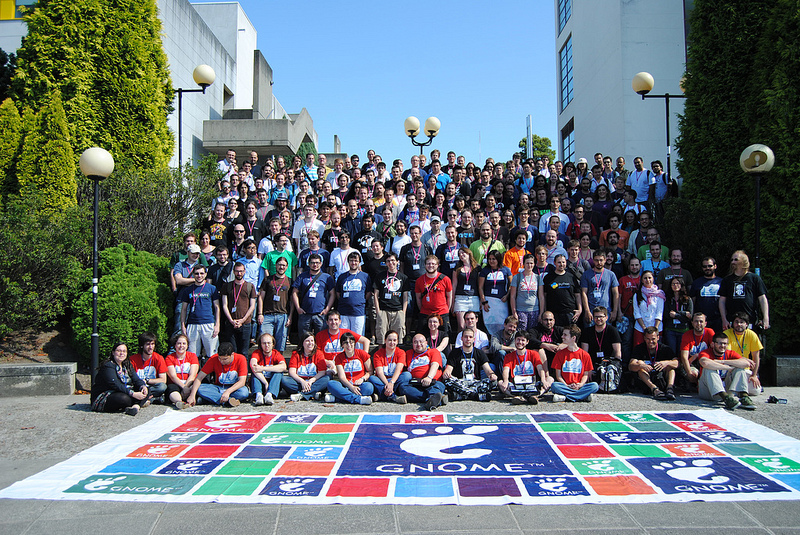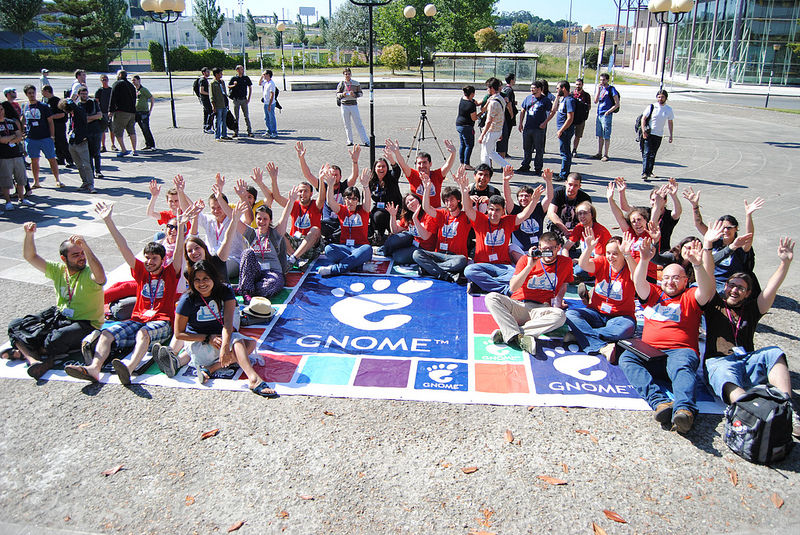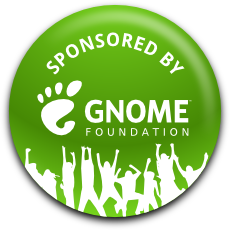GUADEC 2012: How It Was
Two weeks ago, in the beautiful Spanish town of Coruna (La Coruna), the GUADEC conference ended (GNOME U Sers A nd D evelopers C onference, pronounced “guadac”). In this article I would like to tell you how it was, what I learned during the 7 days of this wonderful event and what needs to be done to get to this conference. Carefully, a photo!

Coruña at night
As the name suggests, this event brings together all the developers of the GNOME environment. It is attended by developers, designers, translators, technical writers of the project, as well as interns. Since I am a student myself, I will certainly focus on what needs to be done to become an intern and why it is useful for students.
The conference consists of several parts - the main sections, Lightning Talks (if someone knows the translation of this term - I will be very grateful), BoF (about what it is, I will write a little later) and hackfests.
')

Conference participants

Students and Mentors

Volunteers (people who provided the conference)
The main sections of GUADEC are an important part of this event. They feature the most famous figures of the GNOME project and the world of Open Source. The task of the main sections is to convey to the listener important issues. For example:
Lightning talks - reports lasting 3-5 minutes, designed to focus on one specific problem, or a brief description of the project, its goals, etc. During the conference there were two types of such reports - reports of experienced developers, designers, translators and reports of interns. Both were very interesting.
BoF is an abbreviation of “Bird of Feather”, which in turn is an abbreviated version of the phrase “Birds of a feather flock together”, the Russian equivalent of which would be the expression “Two boots of a pair”. Those. This section implies that people solving one common task (for example, designers, translators, the accessibility team) gather and discuss their vision of this problem, find out what other problems the community should pay attention to, etc. Unfortunately, I did not visit BoF, because during their implementation I had the opportunity to talk with several developers from GStreamer, discuss some aspects of my project, and I could not use it.
The name of this section speaks for itself - the purpose of hack fests is the intensive development of new functionality in the project, fixing bugs, refactoring. The topic of hackfest is determined by the developers themselves and anyone can take part in it.
Anyone can take part in the conference. To do this, you need to register on the website http://guadec.org . On the same site you can book a hotel room and pay for meals. Stay tuned to the site to not miss the next GUADEC.
GSoC students working for GNOME, or whose projects are related to GNOME (for example, GStreamer) and who plan to become members of the GNOME community, members of the GNOME Foundation community can be sponsored by the GNOME Foundation to attend this conference.
Google Summer of Code
First of all, I would like to briefly tell you about Google Summer of Code. This program is designed to attract students to open-source projects. It lies in the fact that at the beginning of the program the student chooses an organization that interests him open-source from the list on the program's website (and this year the list included 175 organizations, so everyone could choose exactly what interests him), selects an idea for his project ( he comes up with himself, or uses one of the proposed ones) and submits an application with a detailed description of the problem’s vision. If the application is liked by the organization, it is claimed and the student can start work. A mentor is attached to each participant - a person from the organization to which the student has submitted an application. The task of the mentor is to observe the progress of the student, help him move in the right direction, give advice.
During the summer, program participants work on their projects, communicate with the community and, if their organizations require it, compile reports on the work done. There are also two mandatory reports that are compiled directly on the program's website - the Midterm Evaluation and Final Evaluation. Reports are made up of both students and mentors. Reports should include your impressions of working in an organization, assess your progress, communicate with a mentor, etc. Neither the mentor nor the student see each other's reports.
I take part in the program a second time and I am not going to stop there. I also can’t but mention the interesting fact related to my university (Chernihiv State Technological University) - it is in the top ten universities by the number of students admitted to the program. And as far as I know, none of the students failed the Midterm evaluation and all my colleagues successfully entered the home stretch. Guys, congratulations! You are great!
Why is GSoC cool? Because in one summer you will meet a lot of interesting people, get invaluable experience, make your contribution to the world of open-source and get $ 5000 at the end of the program.
Program website .
Gnome Outreach Program for Women
In order to attract the fair sex to contributions to the open-source community, the GNOME Foundation created its own program that is held in the winter (yes, girls, you can also participate in GSoC after that). The program is similar to GSoC with the exception that projects can concern not only writing code, but also design, work on documentation, marketing.
After successful completion of the program, as in the case of GSoC, participants receive the same scholarship. In addition, they may also ask the GNOME organization to sponsor a trip to GUADEC. Applications from GNOME interns have high priority.
Program page on live.gnome.org
For girls, there is also the Anita Borg Memorial Scholarship program from Google.
If you have any questions - ask them in the comments or on habraposhta. I am happy to answer.
Thanks to Google for such a cool program like GSoC. Thanks to the GStreamer and PiTiVi communities for support during the program. Also very grateful to the GNOME Foundation for sponsoring a trip to GUADEC. Photos taken by Ana Rey, thanks to her too.

Special thanks to my girlfriend for convincing me to visit GUADEC!

Coruña at night
What is GUADEC?
As the name suggests, this event brings together all the developers of the GNOME environment. It is attended by developers, designers, translators, technical writers of the project, as well as interns. Since I am a student myself, I will certainly focus on what needs to be done to become an intern and why it is useful for students.
The conference consists of several parts - the main sections, Lightning Talks (if someone knows the translation of this term - I will be very grateful), BoF (about what it is, I will write a little later) and hackfests.
')

Conference participants

Students and Mentors

Volunteers (people who provided the conference)
Main sections
The main sections of GUADEC are an important part of this event. They feature the most famous figures of the GNOME project and the world of Open Source. The task of the main sections is to convey to the listener important issues. For example:
- The Problem of Anonymity Online and the Tor Project - "The Tor Project: anonymity online", Jacob Appelbaum
- Using GNOME for educational purposes - “Sugar: using the GNOME platform to build a learning platform”, Simon Schampijer
- OS Design and Architecture - “The UI and the OS”, Lennart Poettering
- ... and many other equally important topics with a complete list of which you can find out by looking at the conference program
Lightning talks
Lightning talks - reports lasting 3-5 minutes, designed to focus on one specific problem, or a brief description of the project, its goals, etc. During the conference there were two types of such reports - reports of experienced developers, designers, translators and reports of interns. Both were very interesting.
Bof
BoF is an abbreviation of “Bird of Feather”, which in turn is an abbreviated version of the phrase “Birds of a feather flock together”, the Russian equivalent of which would be the expression “Two boots of a pair”. Those. This section implies that people solving one common task (for example, designers, translators, the accessibility team) gather and discuss their vision of this problem, find out what other problems the community should pay attention to, etc. Unfortunately, I did not visit BoF, because during their implementation I had the opportunity to talk with several developers from GStreamer, discuss some aspects of my project, and I could not use it.
Hackfests
The name of this section speaks for itself - the purpose of hack fests is the intensive development of new functionality in the project, fixing bugs, refactoring. The topic of hackfest is determined by the developers themselves and anyone can take part in it.
How to take part in the conference?
Anyone can take part in the conference. To do this, you need to register on the website http://guadec.org . On the same site you can book a hotel room and pay for meals. Stay tuned to the site to not miss the next GUADEC.
GSoC students working for GNOME, or whose projects are related to GNOME (for example, GStreamer) and who plan to become members of the GNOME community, members of the GNOME Foundation community can be sponsored by the GNOME Foundation to attend this conference.
Programs for students
Google Summer of Code
First of all, I would like to briefly tell you about Google Summer of Code. This program is designed to attract students to open-source projects. It lies in the fact that at the beginning of the program the student chooses an organization that interests him open-source from the list on the program's website (and this year the list included 175 organizations, so everyone could choose exactly what interests him), selects an idea for his project ( he comes up with himself, or uses one of the proposed ones) and submits an application with a detailed description of the problem’s vision. If the application is liked by the organization, it is claimed and the student can start work. A mentor is attached to each participant - a person from the organization to which the student has submitted an application. The task of the mentor is to observe the progress of the student, help him move in the right direction, give advice.
During the summer, program participants work on their projects, communicate with the community and, if their organizations require it, compile reports on the work done. There are also two mandatory reports that are compiled directly on the program's website - the Midterm Evaluation and Final Evaluation. Reports are made up of both students and mentors. Reports should include your impressions of working in an organization, assess your progress, communicate with a mentor, etc. Neither the mentor nor the student see each other's reports.
I take part in the program a second time and I am not going to stop there. I also can’t but mention the interesting fact related to my university (Chernihiv State Technological University) - it is in the top ten universities by the number of students admitted to the program. And as far as I know, none of the students failed the Midterm evaluation and all my colleagues successfully entered the home stretch. Guys, congratulations! You are great!
Why is GSoC cool? Because in one summer you will meet a lot of interesting people, get invaluable experience, make your contribution to the world of open-source and get $ 5000 at the end of the program.
Program website .
Gnome Outreach Program for Women
In order to attract the fair sex to contributions to the open-source community, the GNOME Foundation created its own program that is held in the winter (yes, girls, you can also participate in GSoC after that). The program is similar to GSoC with the exception that projects can concern not only writing code, but also design, work on documentation, marketing.
After successful completion of the program, as in the case of GSoC, participants receive the same scholarship. In addition, they may also ask the GNOME organization to sponsor a trip to GUADEC. Applications from GNOME interns have high priority.
Program page on live.gnome.org
For girls, there is also the Anita Borg Memorial Scholarship program from Google.
If you have any questions - ask them in the comments or on habraposhta. I am happy to answer.
Acknowledgments
Thanks to Google for such a cool program like GSoC. Thanks to the GStreamer and PiTiVi communities for support during the program. Also very grateful to the GNOME Foundation for sponsoring a trip to GUADEC. Photos taken by Ana Rey, thanks to her too.

Special thanks to my girlfriend for convincing me to visit GUADEC!
Source: https://habr.com/ru/post/149028/
All Articles